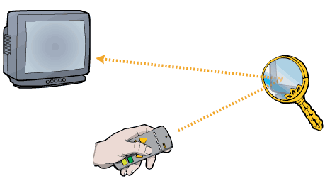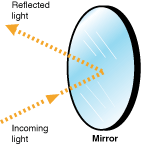Physics in the Living Room: Remote Control Tricks
Few things are as frustrating as searching through couch cushions for a lost remote just as your favorite reality show is starting. What would we do without remotes? In addition to being essential to our TV watching, they are a great way to explore light.

Light pointed at the image of a TV in a mirror will travel straight back to the TV.
What you Need
- TV (or DVD player, stereo, etc)
- the associated wireless remote with working batteries
- a hand-held, flat mirror
What to Do
- Make sure the TV is turned off. Turn your back to the TV and hold up the mirror so that you can see the TV in the mirror. Aim the remote at the image of the TV in the mirror and push the "on" button. Can you turn the TV on?
- Turn the TV off and go into the next room so that you can't see the TV. Set up the mirror so that you can see the reflection of the TV in the mirror. Point the remote at the reflection. Can you turn the TV on? You might have to fiddle with the position of the mirror and the remote.
What’s Going On?

The visible spectrum is a small part of the total light spectrum. Infrared light has a slightly longer wavelength than visible light. Image courtesy NASA.

Light is reflected from a mirror at an angle equal to the angle that it hit the mirror.
The front end of a remote control has a small light bulb. When you press a button on the remote, it sends out an infrared light signal. A detector on the TV gets these signals and tells the TV what you want it to do. Our eyes can't see this light - we can only see what's called the visible spectrum of light - red, orange, yellow, green, blue, and purple. The visible spectrum makes up just a small part of the total light spectrum.
The visible spectrum is a small part of the total light spectrum. Infrared light has a slightly longer wavelength than visible light. Image courtesy NASA.
The remote control system won't work if someone walks between it and the TV because the infrared signal is absorbed by the person. Similarly, it doesn't usually work if you point it away from the TV because the signal doesn't hit the detector.
Light hitting a mirror will bounce off of it at an angle equal to the angle that it hit the mirror with (see the picture below). If you hold the mirror so that you can see the TV in its reflection and then point the remote at this image, you can direct the infrared light from the remote right to the sensor on the TV.
Light is reflected from a mirror at an angle equal to the angle that it hit the mirror.
Try This!
- Set up two mirrors so that the image of the TV in the first mirror is reflected in the second mirror. Can you turn the TV on by pointing it at the second mirror?
- How many mirrors can you do this with before the remote signal is too weak to reach the TV?
- Redo the original experiment but replace the mirror with another reflective surface, such as aluminum foil. Can you still turn on the TV? Try this with other materials and see which ones reflect infrared light.
- Point the remote directly at the sensor on the TV. Place different types of material (water, plastic, paper, etc) between the remote and the TV - what kinds of material can the infrared light pass through easily?











